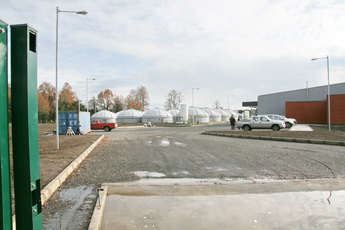De fleste er nok vidende om den heftige debat der føres i både Canada og USA om ekspansion af fiskeopdræt. Der er fokus på såvel påvirkning af de vilde bestande af fisk - primært Stillehavslaks - som opdrætsfiskenes velfærd. For nogle år siden blev der, i Canada, lavet en analyse af mulighederne for at flytte produktionen på land, men en række fejl og begrænsninger i de undersøgte anlæg førte til en ukonklusiv rapportering. Nu overvejer de canadiske myndigheder at gentage analysen - også set i lyset af den hurtige teknologiske udvikling i recirkuleret opdrætsteknologi. Her ligger måske en mulighed for danske udstyrs- og systemleverandører!?

Looking At Closed ContainmentCANADA
- The world's demand for seafood is growing and wild stocks are being
stretched to their limit. That's a reality that more and more people
understand - and those people see the importance of salmon farming as
part of long-term food security, says British Columbian Salmon Farmers.
BC Salmon Farmers are
looking for ways to provide for the global demand for healthy protein in
a sustainable way - and investigating closed containment is part of
that industry development. We're off to a good start.
Salmon farmers are already quite knowledgeable about closed containment
systems because our fish are grown for a third of their life in
recirculation systems on land. Some in the public want to see the entire
lifespan of the fish spent in such systems - suggesting that isolating
farmed salmon from wild stocks would minimize potential impacts on the
environment.
It's a suggestion that seems simple in premise, but is more complicated
in application. In 2008, the Department of Fisheries and Oceans did a
review of 40 closed containment projects from around the world. None
produced exclusively Atlantic salmon and none succeeded. The projects'
failures were due to a variety of factors, such as mechanical breakdown,
poor fish performance, management failure and inadequate financing.
Technology does advance though, and there is news of some small-scale
closed containment projects producing other varieties of fish with
success. That's good news, but it's still only been applied to what is
really a specialty product - not at the commercial scale. To move the
existing net-pen industry on land would take the equivalent space of
7,500 football fields. Capital costs would be prohibitive.
Then there are the other questions that go with the closed containment
debate. Our environmental managers suggest that the footprint of on-land
projects would be unsustainable. The facilities would either have to
run on generators around the clock, burning massive amounts of fuel, or
they'd have to move close to urban centres to connect to sufficient
power.
Veterinarians and farm managers raise concern about animal welfare. Fish
would have to live in much more confined spaces in closed containment,
and because of the constant circulation required to keep the water
clean, they would never be able to rest as they do in the ocean
environment. These factors don't align with increasing consumer interest
in the humane treatment of livestock.
Nonetheless, our companies agree closed containment needs to be
investigated - and are committed to learning more. For example, Marine
Harvest Canada is in the process of hiring a manager to lead a closed
containment pilot project announced in January this year. That project
will benefit from their ongoing dialogue with the Coastal Alliance for
Aquaculture Reform (CAAR).
BC's salmon farmers have proven themselves to be quick adapters to new
technology - as has been seen with benthic monitoring and underwater
feed cameras. If there's a way to do this business better, we'll find it
and implement it. Kilde: fishsite.com
|
